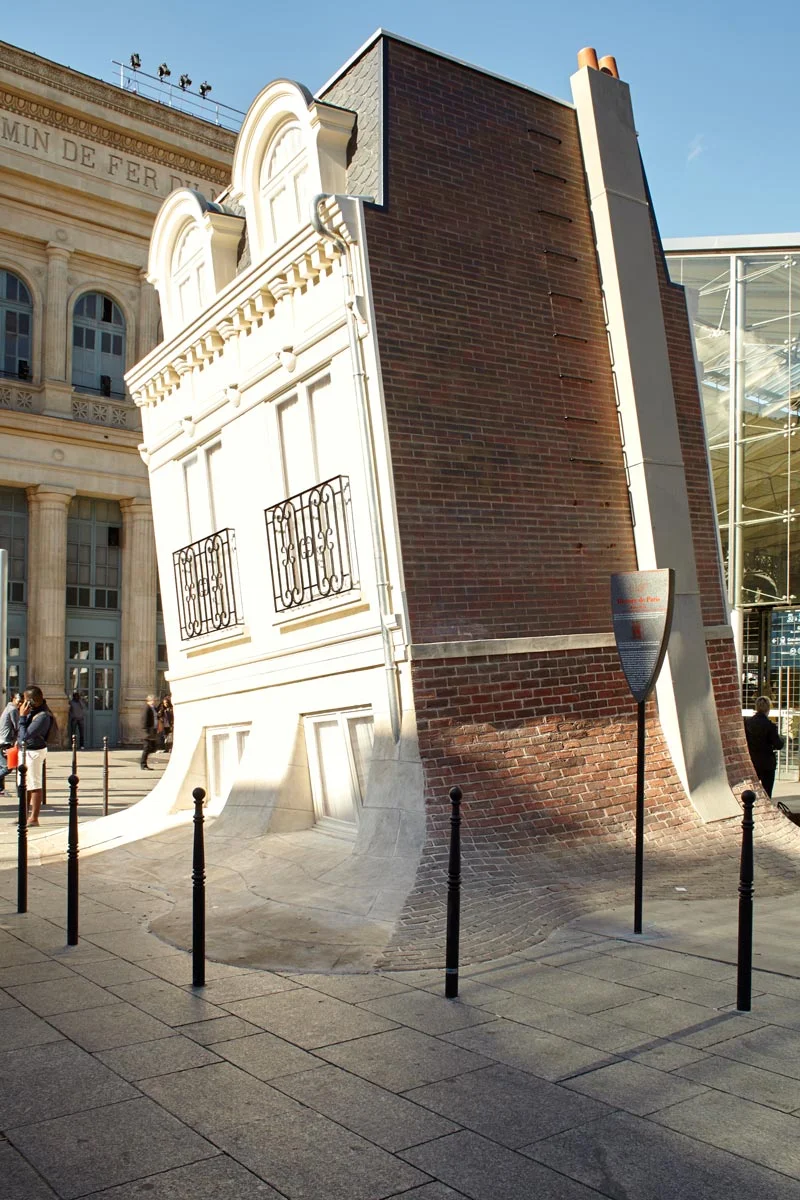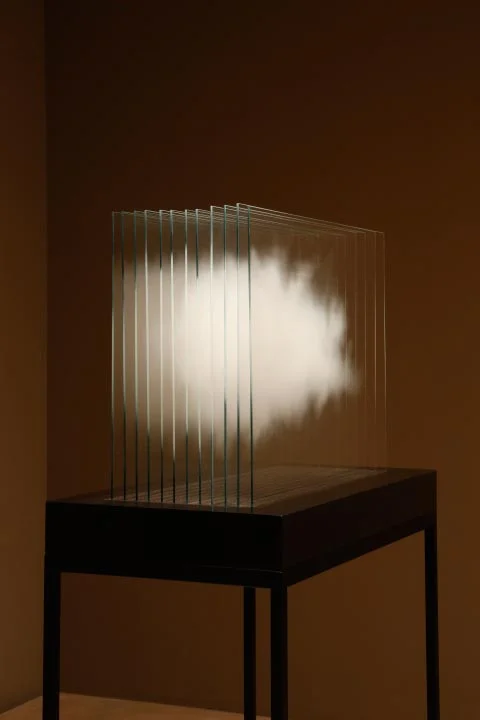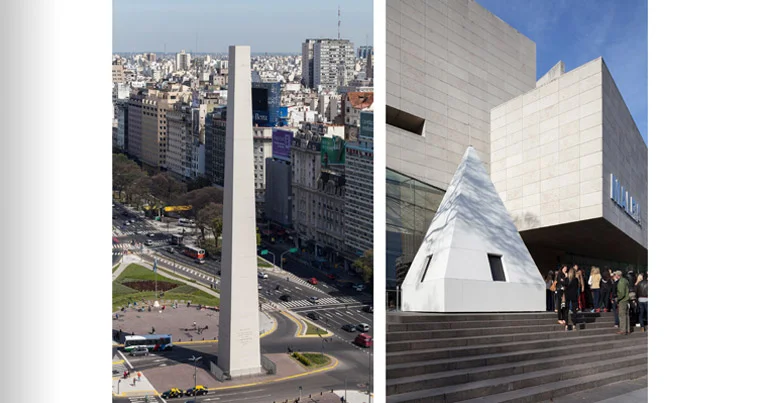
Exhibition view, Maison Fond, (2015). Courtesy the artist. Photo: Martina Maffini.

“The Cloud,” (2014). Ultra clear glass, ceramic, ink, solid surface base. 58 x 85 x 44 centimeters. Courtesy the artist and the 21st Century Museum Of Contemporary Art, Kanazawa, Japan. Photo: Keizo Kioku.

Exhibition view, La Democracia del Sĺmbolo, (2015). Courtesy the artist. Photo: J.A. Rojas.
[](#)[](#)
Leandro Erlich
“Underneath the tons of metal and concrete of our cities, a vital organic presence remains”\*—Where Leandro Erlich Scaffolds His 2015 Coverage in Dezeen
In Argentinian artist Leandro Erlich’s Pulled by the Roots, a “root system sprouts from the concrete foundations of this house installation that dangles from a crane above a construction site in Germany.”\*.1 In simple terms, it’s as though the house is a tooth ripped out of the gums of urban sprawl. Even more, Erlich becomes an artist ripping reality out of its own limitations. Consider: this qualifies as a private installation (the house) set to become a public installation (house AND crane). Is Erlich’s art neither classification?
In 2013, Erlich strategically positioned a massive mirror, angled at 45 degrees. Conceptually simple, but its execution yielded a vertiginous optical illusion; passersby could engage a ground-level installation and appear to “hang” from the façade of a two-story building. Heterochronous being, Borgesian aesthetics. Yes, the artist admits to the influence of Argentina’s most heralded short fictionist Jorges Luis Borges. But travel back to late 2015 and “even gravity”\*.2 is subject to Erlich’s distortional preoccupations. Try this: In September, Erlich’s in situ installation The Democracy of the Sign pulls a monumental trick on Buenos Aires; using a two-ton piece of steel, the artist caps the Obelisk of Buenos Aires, fooling the public into believing it has been “decapitated.” A to-scale replica is then installed at its base esplanade of MALBA (The Latin American Art Museum of Buenos Aires) where visitors can step inside the faux obelisk tip and view the city as though they are 70 meters up in the sky. Erlich’s art bridges the gap between simple phenomenon—a photo and an idea, a building and a crane, a mirror and a façade—and impossible perceptions.
#### **Conceptually, do your pieces begin with a dense concept, or does a physical form appear first?**
Each work or project starts in a different way, but many of them emerge from a dialogue between form and content. Context has always been an inspiration for me. In my experience, concept and physical form are born simultaneously and they grow together in concert.
#### **You have been said to be inspired by fellow Argentine Jorge Luis Borges, who wrote about impossible architecture in stories such as “The Immortal”—is there a direct parallel between his use of magical realism and the fantasy elements of your work?**
Borges was not really part of the realismo magico or magical realism school, a movement that did include authors like Isabel Allende or Gabriel García Márquez. I am often linked to this movement for two reasons: I am from Latin America and my work involves both magic and realism. But I think the parallels stop there. What I have always admired in Borges’ writing is the artistic grace with which he frames philosophical questions.
#### **Works such as “The Swimming Pool,” and “Dalston House,” require the audience’s participation in order to be viewed in their entirety, how important is it for you to involve the viewer in your work? What do you hope that your audience takes away from interacting with your work?**
Installations like “Dalston House” or “The Swimming Pool” are empty stages without protagonists. The audience is needed to complete the work; through that participation and interaction, I hope the audience can enjoy an experience that gives them access to multiple interpretations. In many occasions, to see the other is a way to see oneself (this idea is quite Borgesian). To actively participate allows people to appropriate the work—which is very positive in my mind. I think interaction and participation are key words for our generation.
#### **Your newest piece, “La Democracia del Símbolo,” (“The Democracy of the Symbol”) removes the top from a famous monument in Buenos Aires, “The Obelisk,” and brings it down to the ground, making it and its view accessible to the general population, truly democratic. You have referenced The Obelisk in earlier works, what about it is important to you? How do you feel that its symbolism has changed since it was built?**
Buenos Aires’ Obelisk is Argentina’s Eiffel Tower or Statue of Liberty. It’s the city’s main symbol. What has always appealed to me is how these public symbols become part of the collective imagination. They belong simultaneously to everyone and to no one. Buenos Aires’ Obelisk wasn’t designed for touristic visits; there are no elevators or proper stairs to climb to the apex, which is almost 70 meters high. Everybody knows where the Obelisk is located and often people meet there to celebrate victories in sports or to participate in public demonstrations, yet no one has seen its interior—until now. Public spaces call out for acts of appropriation. By interacting with these architectural sites, we start to own our cities.
#### **There is often a highly developed sense of humor in your work, seen especially in “Maison Fond,” which is a more of a political piece; do you feel that you use humor to soften your message, or to make it more palatable?**
I think humor is important. But humor does not necessarily mean a joke. You can play with humor and be very serious. Personally, I feel there are many issues, thank God, that humor can help us to reflect on.
#### **You said about your collaboration with Hermès in Miami in 2013, that your work and that of Hermès, although working in different mediums, embodied the same sensibility. Can you elaborate on that?**
I have collaborated with Hermès on several occasions. The first time was an ambitious project in Miami for the Men’s Universe event. I was given the chance to create the concept for that evening. I worked closely with Veronique Nichanian, Hermès’ men’s designer for the past 25 years. I think that their brand strategy aims to leave elements of mystery for people to discover on their own. They don’t dumb-down the message for their audience. There’s a certain subtlety that resonates with me.
#### **“A truck with its rear wheels parked on the façade of a building?”\*.3**
I am interested in illusion because it’s a concept that intrinsically questions our sense of reality. I wonder if it’s so appealing because it highlights our need to believe that reality is much “more” than what we ordinarily experience. As for issues of copyright—what can I say? It makes me upset that people from the advertising world often take my work and build on it. I have seen my work posted in many advertising-related blogs. As an artist, I struggle to be creative and original. For me, to copy someone’s ideas or work would be shameful and embarrassing. This taps into my sense of honor. Maybe some advertising directors feel they are honoring me by copying my work? I don’t really know, but luckily I don’t really care. I’m always grateful to enjoy the privilege of working as an artist.
#### **\*** [“Roots trail from house suspended above a construction site by Leandro Erlich,” _Dezeen_, July 2015.](http://www.dezeen.com/2015/07/22/pulled-up-by-the-roots-suspended-house-installation-leandro-erlich-construction-building-site-crane-karlsruhe-germany/)
#### **\*.1** [Ibid.](http://www.dezeen.com/2015/07/22/pulled-up-by-the-roots-suspended-house-installation-leandro-erlich-construction-building-site-crane-karlsruhe-germany/)
#### **\*.2** “[Charlotte McKinney Proves Dancing Can Conquer Anything, Even Gravity,” _Esquire_, March 2015.](http://www.esquire.com/entertainment/videos/a33710/charlotte-mckinney-proves-dancing-can-conquer-anything-even-gravity/)
**\*.3** [_Dezeen_, July 2015.](http://www.dezeen.com/2015/07/22/pulled-up-by-the-roots-suspended-house-installation-leandro-erlich-construction-building-site-crane-karlsruhe-germany/) † _Original question read: Much of your work relies on the idea of the “illusion.” How protective are you of your process? What are your thoughts on copyright restrictions in the art world, and/or Open Source Information?_
